#Salon Big Data PAris
Explore tagged Tumblr posts
Text
En 2024, changeons notre regard sur l’IA : faire table rase du restrictif
Jade BERRE, responsable de conférence au sein du salon Big Data et AI Paris Entre foisonnement d’interfaces conversationnelles, développement des IA génératives et de l’open-source, l’année 2023 a été de bon augure pour l’intelligence artificielle. Cette effervescence ouvre à de nouvelles perspectives intéressantes pour 2024 : usages de l’IA étendus à d’avantage de secteurs, utilisation des IA…

View On WordPress
0 notes
Text
Week One - Poitiers, France
I have officially been in France for a week, which means I’m off to Paris now! I had a ton of fun in Poitiers, enjoying the town and getting to know everyone in the program with me. The classes haven’t been too bad - the French class in particular was pretty chill, just learning numbers, basic greetings, and some general French culture. The engineering class - radiative heat transfer applied to thermal control of satellites - wasn’t as easy, but it was still interesting. We got to use Systema, a simulation software that can give you data about the temperature of different nodes of cubesats (small satellites) based on orbit, conductance, pointing direction, absorptivity/emissivity based on material type, and more. The exams weren’t too bad, especially since there were multiple choice questions for the engineering portion, and you only needed a 50 percent to pass the class (I love the French grading system).
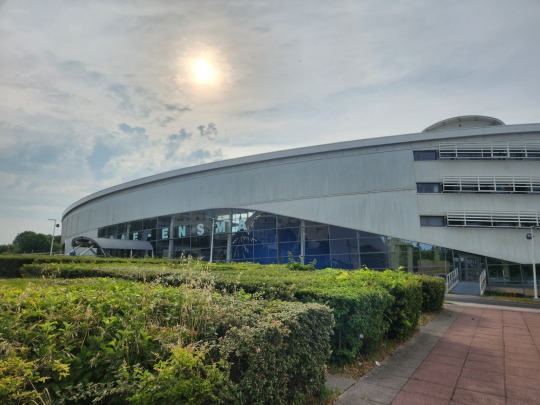
ISAE-ENSMA, the first university we are attending in France.
Onto the fun stuff: on Thursday, we had a guided tour of Poitiers and got to hear a lot of fun facts about the town. There is a myth that as long as one of the statues of the Virgin Mary holds the keys to Poitiers (as she has been for centuries now!), then the English will not attack the city. I also found out that every French city has their own version of the Statue of Liberty, and that they have some walls of buildings in Poitiers where you can still see the architecture from medieval times (something you won’t find in big cities because they were rich enough to tear them down and replace them once it was seen as poor to still have them).

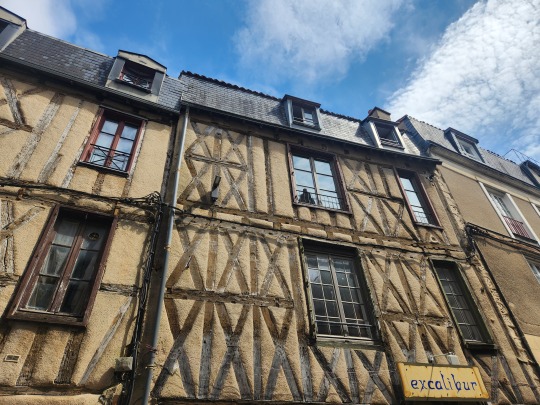
The much smaller Statue of Liberty and the medieval architecture from the tour.
Friday, we got to hang out with the French students who take an English class with our French teacher (sorry if that was confusing. She teaches both groups and thought it would be fun to get us all together, and it was!). We had a game night, and their band played us a few songs.
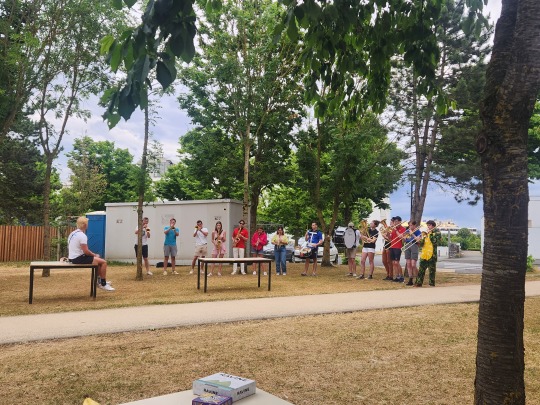


The band playing us music, and a French game described as weird leap frog, where you jump into the line of them and they carry you down before throwing you in the air at the end. Once you're in the front, you get up and jump on. Unfortunately, I was in a dress and couldn't participate :(
Saturday, one of our new French friends took a group of us to La Guinguette, which was a big community space where they had a bunch of food trucks, games, bars, and the soccer game on. It was such a fun place to be (plus the chicken shawarma was really good), so I’m really grateful to know a local who was kind enough to show us!
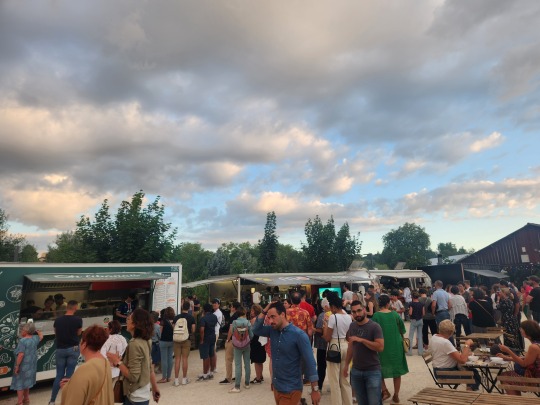
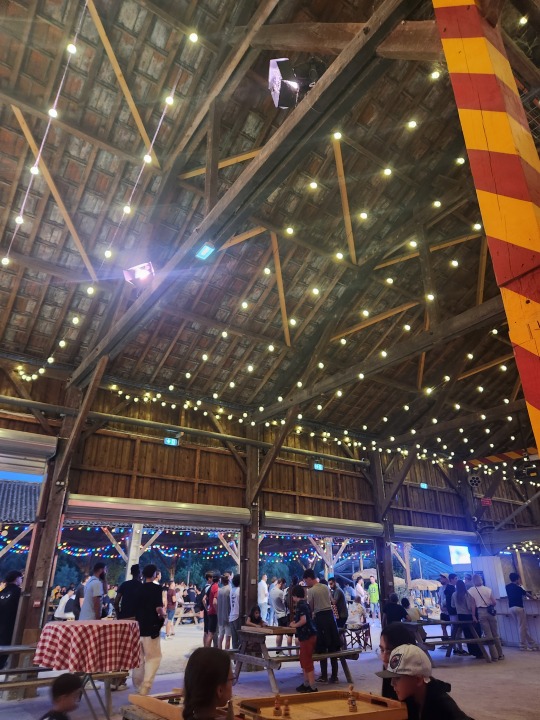
La Guinguette: first the food trucks, then one of the pavilions where you could sit to eat, play games, talk, or watch the game.
Sunday, a big group of us went to La Rochelle, a beach town about an hour and a half away by train, and it was so beautiful. It was a little historical town, so we got to tour these very old towers (some that were used as prisons and actually had really cool artwork carved into the stone from old inmates), which all had great views at the top. It was also nice getting to go to the beach and play volleyball, something we won’t have the opportunity to do until we’re in Salon-de-Provence in about two weeks. I did manage to beat myself up in La Rochelle though - I cut up my feet pretty good in the ocean (it was really rocky with lots of seashells), and I slammed my arms into the walls in order to not wipe out everyone on the steps below me when I started to fall. Don’t wear flip flops on slippery stone floors, kids, even if you were just at the beach.
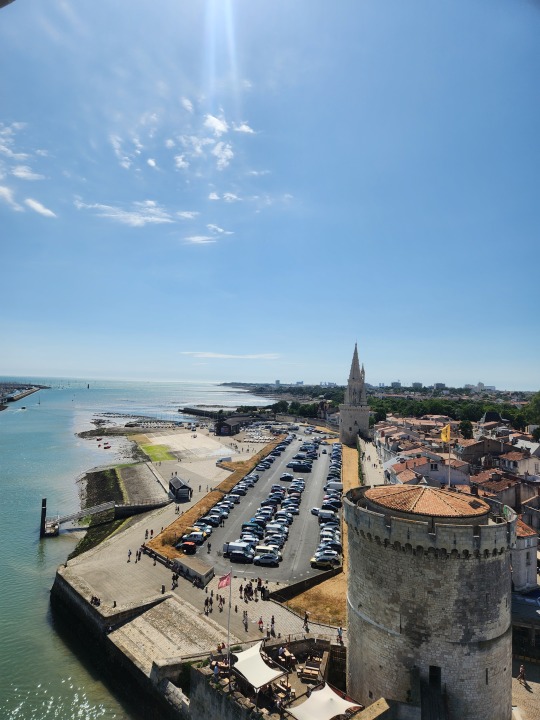
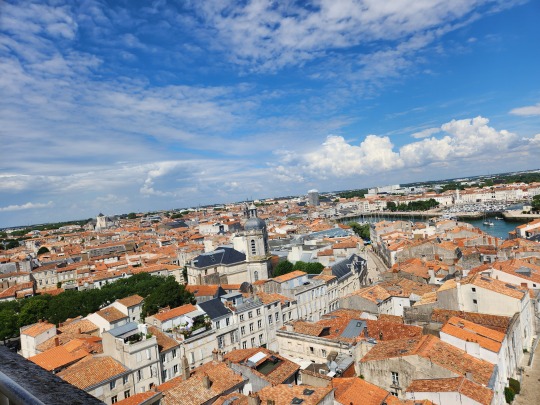


La Rochelle from above (the second picture is taken in the furthest tower visible in the first picture, the spikey one), one of my favorite wall carvings, and moments before the near-disaster (see how narrow the stairs are?).
Monday and Tuesday weren’t all that exciting, mostly just six hours of classes with a two hour lunch in the middle, so we didn’t have time for much else. We did have a picnic at a cute park though, and it was super weird because they had goats, rabbits, and various birds there like you were at a zoo. I’ve never seen that before, but it was nice to go to destress before the exam the next day!
Which leads me to Wednesday; we had our exams in the morning, and after lunch we got to go to Futuroscope. It’s a French amusement park, but not in the traditional sense. There weren’t any roller coasters, though there were a few fair rides. The main attractions were 4D movies/rides. They were all pretty funny, especially when you don’t know much French and just have to guess at the storyline. We split into groups, which I think let us cover more ground (there are 20 of us total), so my group would vary between having five and eight people based on who would come and go. We actually split from the original group almost immediately, though it wasn’t the plan, because there was this giant rope climbing playset (I’ll attach a picture below) that was shaped like a hot air balloon with a giant slide, and we’re all kids at heart and couldn’t resist. After that, we started climbing up everything we could, just for the fun of it. We would still hit random attractions in between (a Tornado Chasers 4D movie was one of my favorites), and we went on this big swing, but the most fun was climbing. We got pretty hungry from all the activity (we walked over 8 miles that day), so we went back to eat then watch a movie.
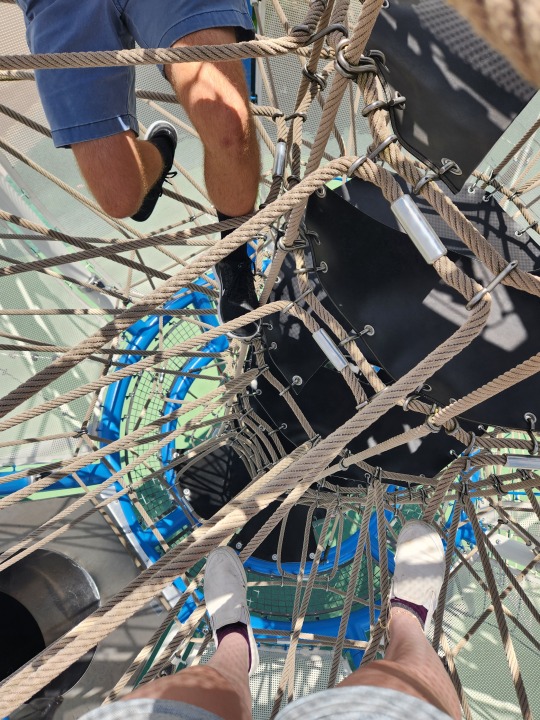
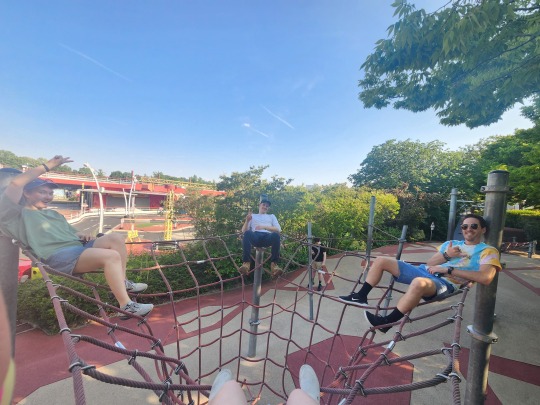

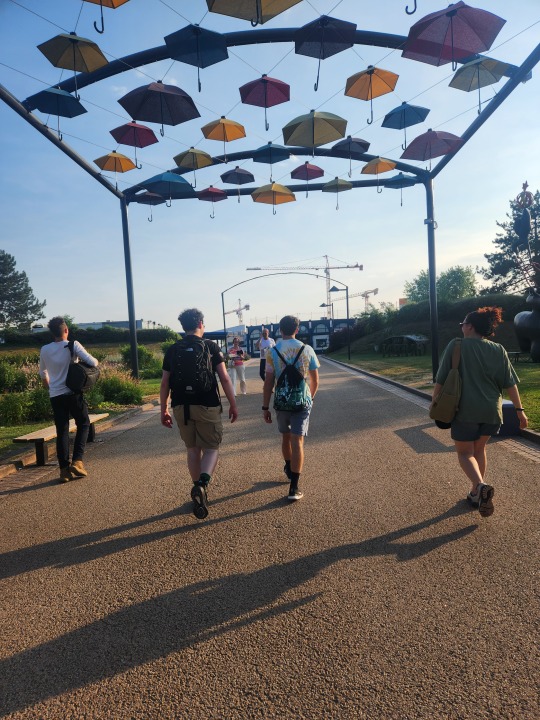
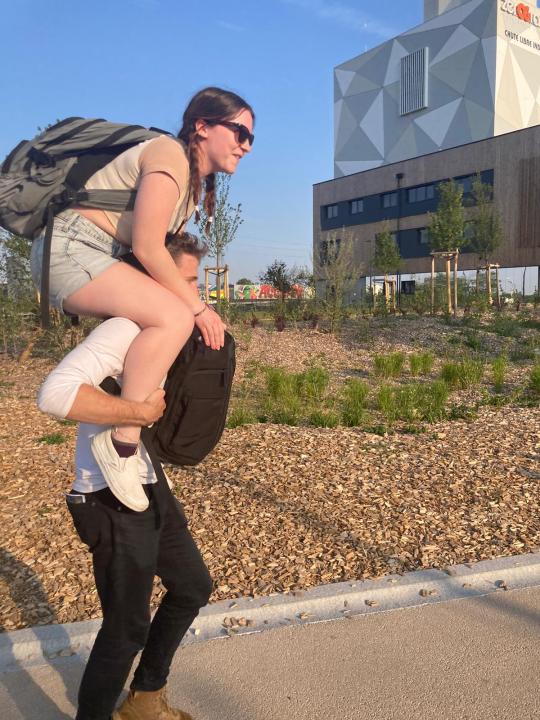
The rope playscapes we climbed and other park shenanigans, feat. me on Sam's shoulders. We were all probably a bit crazy from dehydration by that point.
That’s another thing that’s been happening a decent amount - movie nights! A guy in the program, Sam (the one above), offered up his room a few times to watch movies, so I’ve seen The Batman, Ponyo, and Into the Spider-Verse since being here, and it’s a great bonding experience. The first two were new movies for me, and the last, while not new for me, is to get us all ready to watch Across the Spider-Verse in Paris since they show the movie a few times throughout the day with the original English audio.
Overall, I’ve had a great time in the program so far, and I’m looking forward to our time in Paris and after!
See you next week,
Aryanna Thompson
Aerospace Engineering
Aerospace in Multiple Cities, France
0 notes
Link
U.S. Treasury Secretary Steve Mnuchin and Federal Reserve Chairman Jerome Powell have apparently never walked down a Main Street in America. We make that statement because there is a huge disconnect between what’s really located on a typical Main Street and what’s in the bailout program they’ve designed and are calling the Main Street Lending Program (MSLP).
Americans need to sit up and pay attention to what’s going on here because the U.S. Treasury has committed $75 billion of taxpayers’ money to support this program under the illusion that it’s going to mom and pop operations on a typical Main Street in America. That initial $75 billion will be levered up to $750 billion under the Fed’s ability to create money out of thin air, with taxpayers eating the first $75 billion of losses. Once the loans are originated by a lender, they will then be bought up by a Fed-created Special Purpose Vehicle, thus removing bad loans from the balance sheets of banks like JPMorgan Chase, Wells Fargo, Citigroup and the like. The banks will only have to retain 5 percent of the exposure.
We’ve walked down plenty of Main Streets in America: in West Virginia, downstate and upstate New York, New Hampshire, Connecticut, Florida and in ski towns from coast to coast. We’ve seen plenty of boutique gift shops, family-owned restaurants and ice cream parlors, hair and nail salons, sole-proprietor bake shops, and locally-owned breweries. What we’ve never seen on any of these streets is a shop or restaurant with “15,000 employees or up to $5 billion in annual revenue” or one that needed to refinance $200 million in debt. And yet, that describes businesses that will be able to apply for loans under the Fed’s “Main Street” Expanded Lending Program that has been approved by both Treasury Secretary Mnuchin and Fed Chair Powell.
You have to ask yourself this: if this was really about helping Main Street, why wouldn’t that $750 billion have simply been added to the Paycheck Protection Program (PPP) which is restricted to businesses with 500 or fewer employees – the Small Business Administration’s definition of a small business? The second round of funding to that program by Congress is likely to run out sometime this week. Just under half of all American workers are employed by a small business that has less than 500 workers according to the most recent government data.
The Fed changed the terms of its “Main Street” Lending Program on April 30 in ways that make clear that it’s not at all about rescuing small businesses on Main Street that have been shuttered as a result of mandated government action during the COVID-19 outbreak but is actually all about bailing out the failing debt of the fossil fuel industry and the big banks on Wall Street that hold that debt. Here, for example, is how the Fed describes one facet of the “Main Street” program called the Main Street Expanded Loan Facility (MSELF):
“Eligible Lenders increase (or ‘upsize’) an Eligible Borrower’s existing term loan or revolving credit facility. The upsized tranche is a four-year term loan ranging in size from $10 million to $200 million. The maximum size of a loan made in connection with the MSELF cannot exceed (i) 35% of the Eligible Borrower’s existing outstanding and undrawn available debt that is pari passu in priority with the Eligible Loan and equivalent in secured status (i.e., secured or unsecured); or (ii) when added to the Eligible Borrower’s existing outstanding and undrawn available debt, six times the Eligible Borrower’s adjusted 2019 EBITDA. At the time of upsizing and at all times thereafter, the upsized tranche must be senior to or pari passu with, in terms of priority and security, the Eligible Borrower’s other loans or debt instruments, other than mortgage debt. The features associated with tranches of loans that are upsized in connection with the MSELF (MSELF Upsized Tranches) are outlined in the MSELF term sheet.”
The Fed also explains that the above covenants would not prohibit a borrower “from refinancing maturing debt.” That means that a fossil fuel company could pay off their maturing debt held by JPMorgan Chase or another mega bank on Wall Street (see chart above) which is at a much higher interest rate and refinance it at a little over 3 percent interest under this program. Then the bank can sell that debt to the Special Purpose Vehicle set up by the Fed, keeping just a sliver of exposure on its balance sheet. It’s a win-win for the fossil fuels industry and Wall Street banks and a big loss to anyone who cares about their lungs, those of their children, or the survival of the planet.
Anticipating that the Fed would succumb to lobbying from the fossil fuels industry, on April 15 Senator Ed Markey of Massachusetts and Congresswoman Nanette Diaz Barragán of California, together with 39 other House and Senate members, sent a letter to Mnuchin and Powell asking them to “ignore the pleas of big oil lobbyists” and “instead focus on supporting the workers and small businesses who truly need assistance due to the coronavirus public health emergency.”
The letter also made the following critical points about the fossil fuel industry and the current health crisis:
“In just the last two weeks, the Trump administration has used a combination of enforcement waivers, bargain basement oil and gas lease sales, and a rollback of fuel economy standards to transfer billions of dollars in value of natural resource and clean air benefits from the public to the fossil fuel industry. These actions are especially abhorrent during a pandemic whose burden falls heaviest on Americans with weakened respiratory systems…”
The nonprofit watchdog, Public Citizen, released the following statement by David Arkush, Managing Director of its Climate Program on April 30 when the Fed announced the cozy changes to its “Main Street” lending facility:
“The Federal Reserve today unveiled an expanded ‘Main Street’ business lending program that could allow failing, highly indebted oil and gas companies to borrow money at low rates. In doing so, the Fed heeded a call by U.S. Sen. Ted Cruz (R-Texas) as well as fracking companies to make it easier for oil and gas companies to refinance their debts. The Fed’s new program rules drop an earlier restriction on refinances.
“The Fed should not be in the business of bailing out companies that were in terminal decline and suffering largely from their own misadventures well before the coronavirus pandemic. The fracking industry is notoriously overleveraged, and fracking gas is not even profitable.
“Rescuing fossil fuel production is absolutely the wrong direction for public health amid a global pandemic. Fossil fuel combustion produces air pollution that kills hundreds of thousands of Americans and millions more globally each year. The same pollution also substantially increases COVID-19 mortality. This is all without considering the cascade of public health and economic crises we face due to fossil-fuel-induced climate chaos.
“The U.S. should be working to phase out fossil fuels as swiftly as possible, not rescuing a toxic and reckless industry that is already in a terminal, albeit too slow, decline. The transition away from fossil fuels will require massive investments that will create millions of jobs. U.S. recovery spending that doesn’t directly target public health and blameless companies and workers should be aimed squarely at accelerating this transition, not stalling it.
“The real concern in the oil and gas industry is that workers are losing jobs, as they are in so many other sectors. The response here should be to rescue the workers and provide relief to state and local governments straining to meet the many challenges of this pandemic at the same time as their revenues decline sharply. It should not be to rescue reckless, polluting, humanity-endangering and often dishonest companies that were in plenty of trouble of their own making well before this pandemic began.”
That last sentence could just as easily apply to the Wall Street mega banks that are also being bailed out of their reckless loans and were also “in plenty of trouble of their own making well before this pandemic began.”

6 notes
·
View notes
Text
CGI sur le salon BIg Data
Retrouvez CGI sur le salon #BigDataParis cc @CGI_FR @cgirecrute_fr #BigData #DataScience #DataInsights #DataAnalytics https://buff.ly/35gUeTV

0 notes
Link
All cities have gone through the ebb and flow of social distancing and lockdowns, with regulations repealed as cases decline and hurriedly re-imposed when cases return. But few urban residents likely feel as dislocated as those living in Manila. The capital of the Philippines went through a three-month lockdown, starting in mid-March and ending in early June. Then, as residents started to return to work, a spike in cases in early August led the government to reimpose lockdown measures. Yet these measures were repealed merely two weeks later, as the economic pain of shutdown began to take hold—evidenced in a record 45.5% adult unemployment rate.
Manila is just one example of how the economies of megacities—cities with large and growing populations, often exceeding ten million—in developing countries have struggled to protect their residents and keep their economic engines running. It is an indication of the flaws inherent in an economic model focused on rapid and widespread urbanization. Megacities are not the future because they thrive on cheap labor and government policies fuel this abuse. Stagnant rural economies encourage people to move to the cities, hollowing out rural communities and leaving a hole often replaced by an increasingly concentrated and industrialized agricultural system.
Singapore, on the other hand, is a good case study of how even the most modern cities are vulnerable to those who they most rely on, and who they take for granted. In March, Singapore was being hailed as a model for beating the virus. Cases were low and the city remained open—until it was discovered that the virus was running rampant through the city’s migrant worker dormitories.
In cities across the world, migrant worker and minority communities have been hit hardest from the coronavirus. One U.K. report found that those from its ethnic minority community were 50% more likely to die from COVID-19. Data from the United States shows that minority communities, especially Black, Latinx, and Native American communities, see significantly higher rates of cases and deaths.

Photo by CARL DE SOUZA/AFP via Getty Images A girl covers her ears as people disinfect an area at the Babilonia favela, in Rio de Janeiro on April 18, 2020.
These are advanced economies with ample resources (though maybe not the political will to apply them universally). But with the prominent exception of the U.S., today’s COVID-19 hotspots are found throughout the developing world. In Brazil, favelas in São Paulo and Rio de Janeiro are organizing their own support networks due to the lack of adequate government infrastructure. Cities in Colombia have seen spiking death rates as medical systems collapse. One recent study in Mumbai’s slums found that over half of slum dwellers had antibodies for SARS-COV-2.
Some commentators have looked at the pandemic and asked whether the time of the “superstar city” is over, as the pandemic makes population density look like a danger rather than an opportunity for productivity gains. They’ve suggested that the pandemic may finally lead to an exodus from cities, as young professionals, fed up with the high cost of living and nightmare commutes, and freed by the shift to remote work, leave for rural communities.
But this idea is focused on advanced economies and, specifically, on the upper and upper-middle classes within them. In growing economies, mass urbanization will remain the focus, as it is still seen as the best, if not the only, vehicle for economic development, moving people from the “unproductive” countryside to the more productive cities. By emptying rural hinterlands with its demand for low-paid workers, this urbanization ultimately leads to more unstable, more damaging, and more unequal economies.
Read more: The Photos Show Life in the Poorest Towns in America
World economic growth in recent history has been centered on a few superstar cities: New York, London, Tokyo, Hong Kong, Paris and more recently Shanghai, for example. London makes up 30% of the UK’s economy, has 13% of its population and is more than eight times as populous as the country’s second largest city, Birmingham. So-called emerging markets have relied upon urbanization to drive growth. Turning rural labor into urban labor was seen as a positive for productivity.
But the pandemic has highlighted the inequality and unsustainability of these cities. A population of urban professionals, with safe and secure lifestyles, is supported by a large and poorly-paid service sector. These people work in the grocery stores, hair salons, restaurants, bars, and gyms, and live in poor neighborhoods or even slums. They deliver food, fix homes, cut hair, dispose waste, keep transport systems running, clean suburbs, look after children, and walk dogs. These underpaid workers have either seen their livelihoods evaporate in recent months, or have been forced to risk their health by providing essential services, because they do not have the choice of the privileged work-from-home crowd. After all, you cannot work from home if your job is keeping the hospitals working or the sewers in operation.

Photo by INDRANIL MUKHERJEE/AFP via Getty Images Residents wait to get themselves checked during a COVID-19 coronavirus screening in the Dharavi slum in Mumbai on August 11, 2020.
Even before the pandemic, these workers tended to live unstable lives. The high-cost of living in megacities forces many of them to live in slums or peripheral communities. The expansion of cities beyond the ability of infrastructure to cope means these communities have lower-quality housing, worse access to education, poor provision of electricity and clean water, bad sanitation, traffic congestion, dead spots for internet and mobile access, and “food deserts.” Worse, urban lifestyles are increasingly oriented around the so-called innovation of the gig economy: service workers now lack even the basic protections afforded to proper employees.
Read more: ‘It’s a Race to the Bottom.�� The Coronavirus Is Cutting Into Gig Worker Incomes as the Newly Jobless Flood Apps
Yet in times of crisis, like the pandemic, these workers are seen as a disposable, redundant or even a threat. Without protections, they are unceremoniously expelled from the city. The lockdowns in India led to a huge and uncontrolled migration of day laborers back to their homes in rural communities—a reaction that almost certainly worsened the spread of the pandemic.
In addition, the massive amount of resources used to power urban economies have significant social and environmental effects on rural communities throughout the world. The effects of urban pollution and waste—from landfills to smog to dirty water—are also disproportionately placed on rural communities. Even when cities are sincere in their efforts to improve their environmental impact, they often ignore the ways they harm the countryside and the free ride they enjoy from the under-priced services of the hinterland.

Photo by Mark Makela/Getty Images An abandoned house is spray painted “Trump!” on August 14, 2016 in Schuylkill County, Pennsylvania. This Northeastern Pennsylvania region has a rich coal mining history, but the majority of nearby coal mines have closed.
This leads to political discontent: a feeling that urban communities benefit from the resources and work of rural communities, while imposing rules and regulations on them. This is part of the background behind political phenomena like Brexit, the Donald Trump presidency and the rise of European populism.
Whether or not pandemic-driven de-urbanization happens on its own, governments should leverage this period to create a balance between urban and rural economies that is sustainable. While the impacts of remote work and other digital technologies are probably not as great as their promoters claim, it is true that they reduce the unique value that density provides and may finally dent the allure of large cities for white-collar workers.
Governments should consider three policies in particular:
Greater investment in rural areas to make them more compelling places to live. This does not just mean utilities, education systems and health care services, but also cultural institutions to help balance the significant soft power major urban centers hold.
Support for small businesses, including protections against competition from larger firms. Rural economies live off small business, but a hollowed-out economy and greater competition from national and global firms run them out of business. A lack of local economic vibrancy encourages people to leave for the city. This replaces small business and the family farm with large-scale industrial agriculture and big companies, which reduces social mobility and industrializes the food-supply chain.
Redistribution of income between urban and rural areas. Governments should funnel public revenues raised from urban areas towards resolving burdens placed on rural areas by cities. And it must also ensure that revenues are directed towards addressing imbalances, whether through building new infrastructure or resolving some of the external costs that are placed on rural communities, such as groundwater contamination or loss of arable land.
Cities will always be useful to national economies, but they have grown into unmanageable Frankensteins. Yes, there really are some things that can only be done in a dense, urban environment but that does not mean turning a blind eye to growing megacities with over five million people. Countries probably don’t need the extreme urbanization we’ve seen over the past few decades, nor should we be strangely resigned to the notion that urbanization is inevitable and a net good. The time has come to rethink whether we should continue to place cities at the heart of our nations, turning them into large parasitic centers which practice economic apartheid.
0 notes
Text
SXSW, Big Data Paris, salon auto de Genève, Présidentielle du numérique… quoi de neuf cette semaine ?
SXSW, Big Data Paris, salon auto de Genève, Présidentielle du numérique… quoi de neuf cette semaine ? Quoi de neuf cette semaine sur la planète tech ? Après le MWC 2017, les pépites françaises du numérique se dirigent à Austin, au Texas, pour le South by South West.
0 notes
Text
San Francisco Spent A Decade Being Rich, Important, And Hating Itself
David Paul Morris / Bloomberg via Getty Images
A rider on a single-wheel electric scooter moves past a person adjusting their belongings on a sidewalk in San Francisco, Oct. 14.
In December 2019, as the decade drew to a close, thousands of 10-inch-long penis fish flopped ashore at Drakes Beach, about 50 miles north of San Francisco. Otherwise known as the fat innkeeper worm (Urechis caupo), the invasion of the phallic critters took over the beach, forcing out the locals. If you were looking for a metaphor to sum up what a decade of growth in the high-tech industry has done to the Bay Area, you couldn’t ask for something more apt. Unless, of course, the penis worms were libertarians.
Because, from a certain point of view, that’s been the core story here since the end of the Great Recession. Hordes of newly minted and newly wealthy tech bros, flush with Silicon Valley VC cash, ruined what once had been an all-are-welcome cool, gray city of love, where the funky landlady Anna Madrigal offered furnished rooms on Russian Hill for $170 a month. As the Jefferson Airplane guitarist Paul Kantner once joked, “San Francisco is 49 square miles surrounded by reality.” If that were ever true, this was the decade in which reality finally closed back in.
At the end of the decade, how did the Bay Area end up in such dire shape? Perhaps our politicians, bought and sold by big business, opened the gates to a wave of capital and an influx of outsiders. That’s one way to tell the story of the decade of the technology industry in its capital, the San Francisco Bay Area.
And so, when the tech industry reignited our economy, we — newcomers and locals alike — didn’t have the capacity to grow.
But there’s another, which is perhaps more apt. In December, San Francisco’s Planning Commission approved the construction of five duplexes in Bernal Heights, where the median home price is just under a million and a half dollars. In the middle of the region’s excruciatingly well-documented and seemingly near-permanent housing crisis, it didn’t take the commission a month to approve the construction, or even a year. It took 41 years — four decades to approve just 10 new units of housing on a vacant hillside, kept that way by the opposition of neighbors who opposed construction, quite literally, in their backyards, and a system that prioritized their preferences over our needs.
This isn’t an anomaly. Across the street from Apple’s headquarters in Cupertino, a developer proposed to convert an all-but-empty mall into 2,400 homes. City voters said no. In 2013, San Francisco voters rejected a 141-unit condo building on the waterfront. Across the region, city councils, beholden to voters concerned about their own property values, dragged their feet in approving new housing. And so, when the tech industry reignited our economy, we — newcomers and locals alike — didn’t have the capacity to grow.
Politics is much less about who your friends are than who your enemies are. And in the last 10 years, the easiest enemies to find were the techies and the nimbys.
When he became the mayor of San Francisco in January 2011, Ed Lee presented himself as a compromise figure, one who could build consensus among the ever-warring factions of the city’s Democratic party. “I present myself to you as a mayor for everyone,” he said at the time. “A mayor for neighborhoods, a mayor for downtown, for business, for labor, for the powerless and the powerful, for the left, the right, and everyone in between — for everyone.”
In 2010, during the trough of the Great Recession, the regional unemployment rate reached 10.5%. So the next year Lee and the Board of Supervisors (San Francisco’s name for its city council) passed what became known as the Twitter tax break, an exemption on payroll taxes for new employees for six years. At the time it was estimated the legislation would save the company $22 million, in exchange for which it abandoned a threat to leave town for the valley, and moved to the offices it still occupies today, a stately building on the corner of Market and 10th streets.
For a moment, the Twitter tax break seemed as if it would make good on Lee’s promise to bring the city together.
The deal united members of the moderate wing of San Francisco’s Democratic Party with the progressives. It lured not just Twitter but several other tech companies, including customer service software maker Zendesk, to locate in a seedy part of San Francisco, better known for drug dealers than disruptors. When he unexpectedly ran for reelection in 2011, Lee’s allies cut a deeply goofy, but not unfunny campaign video featuring Facebook’s Sean Parker, Twitter’s Biz Stone, and Yahoo’s Marissa Mayer, Giants pitcher Brian Wilson, and rapper MC Hammer.
Lee won in a rout, but the era of good feelings was short-lived.
In October 2012, San Francisco magazine ran a story by Salon founder David Talbot that posed the question that would dominate the rest of the decade. The title of the story said it all: “How Much Tech Can One City Take?”
Talbot’s answer: as little as possible.
“The unique urban features that have made San Francisco so appealing to a new generation of digital workers — its artistic ferment, its social diversity, its trailblazing progressive consciousness — are deteriorating, driven out of the city by the tech boom itself, and the rising real estate prices that go with it,” he wrote, adding, “And it’s not just about housing. Many San Franciscans don’t feel as if they’re benefiting from the boom in any way. While 23-year-olds are becoming instant millionaires and the rest of the digital technocracy seek out gourmet restaurants and artisanal bars, a good portion of the city watches from the sidelines, feeling left out and irrelevant.”
The progressive narrative hardened from there: Lee, desperate to attract businesses, had sold out the city to high-tech, throwing open the gates to every “Stanford asshole” (as Talbot would later put it) with a pulse and a business plan. Enter stock options, exit the soul of the city.
It was only a little more than a year later, in December 2013, that the next front in the local war against tech would open — this one covered in vomit.
Christiane Hübscher / Picture Alliance via Getty Image
Google busses pick up employees on the car park of the company in Mountain View, California, Nov. 6, 2015.
Because of the region’s clogged freeways, poorly designed public transit systems, and lack of housing near the main campuses of companies like Google, Facebook, and Apple, several tech giants had for years offered their employees shuttles to and from work. That winter, activists in San Francisco and Oakland blocked the path of the private shuttles that ferried workers who lived in the cities to their offices in Silicon Valley.
Demanding that tech companies pay for use of city streets, the protesters handed out a communiqué that blamed the tech industry for the rising cost of housing. (From the lowest point of the recession, the median inflation-adjusted cost of a home in the region had risen over $100,000 in just two years by 2013.) “Rents and evictions are on the rise,” they wrote. “Tech-fueled real estate speculation is the culprit. We say: Enough is Enough! The local government, especially Mayor Lee, has given tech the keys to shape the city to their fancy without the public having any say in it. We say, let’s take them back!”
The first protest occurred in December, and they lasted until April. In San Francisco’s Mission District, protesters stood in front of the buses as they loaded passengers. On the freeway, someone shot a projectile through a window. And in April in Oakland, a masked anarchist climbed on top of a bus and puked on its windshield.
Everyone had a hot take about the Google Bus protests. (This one was mine.) A UC Berkeley professor wrote that they were “synecdoches for the anger that many San Francisco residents feel towards technological privilege and its facilitation of a widening of a class divide in the city.” Media theorist Douglas Rushkoff rushed out a book that argued that protests showed that “the digital economy has gone wrong.”
Eventually, San Francisco’s city government muddled to a compromise. But by then, the issue had taken on a weight more symbolic than substantive.
The Google buses symbolized “the spaceships on which our alien overlords have landed to rule over us.”
And depending on which camp you found yourself in, there was one of two essays you’d brandish at dinner parties, yell about on Twitter, and pretend to have read that explained what the protests symbolized.
One was by the prolific writer Rebecca Solnit (Men Explain Things to Me) and published in February 2013. In the starkly titled “Google Invades,” she argues that the Google buses symbolized “the spaceships on which our alien overlords have landed to rule over us,” and compares the tech workers to the Prussian army invading Paris, while noting in passing that she, a Connecticut native, had sold her Mission District apartment to a Google engineer in 2011.
From one point of view, Solnit was a lyrical truth-teller. From another, a Boomer hypocrite, who benefited smartly from gentrification before decrying it.
It took until the following year for those inclined to the second point of view to find their voice, which came under the guise of a long post at TechCrunch by journalist Kim-Mai Cutler in which she tries to figure out how, as her title went, “burrowing owls led to vomiting anarchists.”
“NIMBY-ists in every city try and shove the housing issue onto someone else.”
To hear Cutler explain it, it wasn’t the tech industry that caused housing prices to skyrocket. Rather, it was a collective action problem: Too many people, for reasons that made sense individually, opposed new housing. That meant that, collectively, we were straight out of luck.
Thanks to homeowners protecting their prices, activists concerned about gentrification, preservationists fretting about the erosion of the physical traces of history, and environmentalists protecting those burrowing owls, San Francisco and the rest of the Bay Area simply had not built enough housing to keep up with demand. The city “has added an average of 1,500 units per year for the last 20 years. Meanwhile, the U.S. Census estimates that the city’s population grew by 32,000 people from 2010 to 2013 alone,” she wrote. And what was true of San Francisco was true of every other city in the Bay Area, which added some 600,000 people over the course of the decade: “NIMBY-ists in every city try and shove the housing issue onto someone else.”
Justin Sullivan / Getty Images
A homeless man sleeps on the sidewalk near San Francisco City Hall, Dec. 5.
The first time I met Sonja Trauss, we were breaking and entering. Coffees in hand on a sunny afternoon, we ducked under a railing at the Transamerica Pyramid to sit in a spot it didn’t quite seem we were allowed to be.
The former math teacher had just founded the SF Bay Area Renters’ Federation, an advocacy group of tenants that argued for more housing. It was the first moment in what became the “yes in my backyard” — YIMBY — movement. Trauss gives much of the credit for the spark to Cutler, telling me back then that the article “made organizing pro-density renters easier.”
Since then, the YIMBYs, and their elected allies, have notched several victories. In 2014, San Francisco Supervisor David Chiu narrowly defeated Supervisor David Campos, whose response to the housing crisis in his part of San Francisco was to propose a moratorium on market-rate housing construction, a measure that the voters defeated. Two years later, their colleague, Supervisor Scott Wiener won election to the state Senate. Wiener would go on to become the most consistent state legislator in working to accelerate the production of new housing, the author of a bill that would require cities to locate dense housing near transit hubs. YIMBY-supported candidates would also win office as San Francisco, Oakland, and San Jose mayors, although Trauss was heavily defeated in her own bid for the San Francisco Board of Supervisors in 2018.
“They aren’t leaving because they want to.”
Trauss lost in part, she thinks, thanks to a perception that the YIMBYs still represent short-timers, young workers who are not yet invested in where they live. “It was so sad,” she says. “I would talk to people who had lived here for 20 or 30 years. They would say, ‘These young people come to this city and leave after three years. They don’t even care. They are just here temporarily.’ They aren’t leaving because they want to. They are coming here, really trying to stay, and getting pushed out. You see that happening, and you think they are here for an extended vacation, but it’s really a pathological process. They are displaced.”
And while it’s true that their groups have broad support today, the YIMBYs drew much of their earliest support from leaders of the technology industry, including a $100,000 gift from Yelp CEO Jeremy Stoppelman and fundraising help from Nat Friedman, a Microsoft vice president. Critics seized on that funding to claim that Trauss, were she not a shill for developers, was a tout for the reterritorialization of the cities by tech-fueled neoliberal capital. As former chair of the Berkeley Planning Commission Zelda Bronstein wrote in 2018, “Yimbys propagate the capitalist growth imperative. Using housing as a proxy for growth, they endow the limitless expansion of population with a seductive moral charge.”
And many in the tech sector went out of their way in the last decade to be impossible to defend. There were world-historical villains like Peter Thiel, the billionaire who sued Gawker into oblivion after it outed him, and Tom Perkins, the venture capitalist who wrote the Wall Street Journal a letter during the Google bus protest to “call attention to the parallels of fascist Nazi Germany to its war on its ‘one percent,’ namely its Jews, to the progressive war on the American one percent, namely the ‘rich.’”
We had local-level assholes, too.
There were state-sized targets of ire, too, like Sun Microsystems cofounder Vinod Khosla, who bought a coastal property in 2008 in Half Moon Bay, south of San Francisco, and tried to cut off access to the public beach there. Or venture capitalist Tim Draper, who made California voters waste their time on his proposal to split the state into six for no better reason, it seemed, than he was bored. Even San Francisco’s old money low-key hated guys like them, if you believe Vanity Fair.
We had local-level assholes, too. Startup founder Peter Shih wrote a 2013 Medium screed complaining that San Francisco was filled with “49ers, [women] who are 4’s but behave like they are 9’s.” There was Greg Gopman, a hapless techie who excoriated San Francisco’s homeless in graphic terms. “In downtown SF the degenerates gather like hyenas, spit, urinate, taunt you, sell drugs, get rowdy, they act like they own the center of the city,” he wrote the same year. “Like it’s their place of leisure.” Then there was Sarah Slocum, who got thrown out of Molotov’s, a Lower Haight bar, in 2014 for wearing Google Glass and claimed she was the victim of a hate crime. And the less we talk about T.J. Miller’s 2015 performance at the Crunchies, the better.
And I haven’t even mentioned Larry Ellison, the Oracle cofounder who inflicted his fancy boat race on us in 2013, at which his yacht-racing team cheated.
Point being: This decade has been such that, were you inclined to agree with Cutler or with Solnit, you could find plenty of evidence to support your point of view.
Justin Sullivan / Getty Images
Housing activists stand in a mock living room during a demonstration in front of a home on the verge of being foreclosed on in San Francisco, Nov. 22, 2011.
As the decade comes to a close, in many ways we’re no closer to a synthesis than when we started. Tech’s villains continue to be awful, both individually and collectively. And our housing production remains anemic.
And yet there are signs of hope.
In search of it, I head to the roof of the Hamilton Families shelter in the Tenderloin. Here, standing next to her husband and Mayor London Breed, YouTube CEO Susan Wojcicki announces that she is donating $1.35 million to the nonprofit (Google.org gave $850,000 and Wojcicki $500,000). Wojcicki discovered the shelter, which houses 200 people and serves some 500 more, after her daughter was assigned a school project on homelessness. The two visited, and Wojcicki decided she’d like to be more involved.
The donation is part of a larger push by the tech giant, which bought the video site in 2006, to address housing and homelessness. In June, the company announced a $1 billion investment, comprising the development of 15,000 new homes on property it owns, a $250 million investment fund to support affordable housing subsidized for low-income people, and $50 million in grants to nonprofits. In October, Facebook made a similar commitment that it estimated at $1 billion and In November, Apple did too, at an estimated $2.5 billion.
Toting up all three, if all of the promised projects were to come to fruition, it would bring at least 35,000 new units of housing online (Apple has not made public how many housing units it intends to build), something like three times all the new housing construction in the region in the past year.
On the roof of Hamilton Families, I meet the chief of public affairs for Google in California, Rebecca Prozan. She’s something like a diplomat for the company, working to keep local officials as happy as they can be. It’s ironic, but although the company has power that exceeds nation-states, its plans to redevelop its Bay Area still need to be approved by city councils representing 80,000 people.
Google would rather not be in the shuttle business, she tells me. Those commutes are long — two or three hours a day — and that’s why the company is hoping to develop mixed-use projects in San Jose, near the Diridon train station, as well across the region.
Prozan understands that the backlash to the industry in which she now finds herself is real. But she attributes it to a fear of change. The neighborhood restaurant closing. The owners of a long-popular bar deciding they wanted to sell. The shuttles became a visual representation of that, she thinks, but not the cause.
The shuttles seemed to have raised prices in areas right near the stops.
I do think she’s mostly right, although I disagree about the shuttles. Recently, I changed my mind on their impact, thanks to this research paper by Brian Asquith, an economist at the W.E. Upjohn Institute. He found that within a kilometer of the shuttles, prices of homes went up and so did evictions of renters. “A fair interpretation of my work is that the shuttles seemed to have raised prices in areas right near the stops,” Asquith told me. “Every kilometer you get closer to the shuttle stop, prices appreciated by 5 to 18%.”
But, as Prozan rejoins when I tell her about the study, that’s likely true of public mass transit as well — and not an argument against building bus and BART stops. And besides, she points out, commuting in a shuttle is better for the environment and congestion than commuting in individual cars.
As much as I find to agree with when I talk to Prozan, Google seems like an outlier. Too big, too rich, and frankly, there’s plenty on the negative side of the ledger. The day after we speak, the company fires a fifth employee activist for questioning its policies. Google is so big and important that it’s only a stand-in for Google. To figure out what the Bay Area’s equilibrium might look like in the next decade, it helps to look elsewhere.
In the mid-Market neighborhood, a few blocks from Twitter and a massive fancy retail space that’s stood unoccupied since it was finished in 2016, is Zendesk. I’m in an upper-story office, surveying the Crazy Horse strip club with Tiffany Apczynski, the vice president of public policy and social impact at Zendesk, who points out that in renderings of a new building to be constructed next door to it, the architectural firm was careful to leave out the strip club. A former journalist, she still has an eye for a compelling anecdote, and I appreciate it, because it perfectly sums up the jostling tension between the old and the new, or the present and the future, here in the neighborhood that feels like the crucible of tech in San Francisco.
Zendesk, which makes customer service software, is far less known than Twitter. But it also benefited from the tax break, and now employs 1,100 people across 174,000 square feet in four buildings in mid-Market — including, oddly enough, the space where BuzzFeed used to have our San Francisco office. (We didn’t get the tax break.)
“Jackson, Mississippi, is in 1985, and they want to get an economy. So, careful what you wish for.”
In 2011, when Apczynski’s company moved here, it had 60 employees. “I recognized right away that this could go in a really bad direction,” she says, so she set about getting its coders and product managers out into the community, rubbing shoulders with people living on the streets. The company’s employees have run bingo games at the Curry Senior Center, assembled harm-reduction kits at Glide Memorial Church for people with drug addictions, and, as part of their first-day orientation, each one volunteers at the St. Anthony Foundation, which serves meals to the homeless. Next year, one of Zendesk’s designers will help St. Anthony’s redesign their clothing giveaway program.
“We didn’t want to be heroes,” she says. “but we did want to be neighbors.”
Apczynski is a 25-year resident of San Francisco, and plans to run for office here someday. But she worries that her 7-year-old daughter might not be able to afford to live in the city she’s growing up in. “If things don’t change, she probably won’t be able to afford to stay here. I want my baby girl living next to me as long as she can,” she says.
Apczynski recognizes that her company had to build trust — and that it took many years. And she’s not blind to the attitude that the Bay Area could solve many of its problems if it simply drove the techies into the Bay. She rejects that idea, though.
“I’m on the board of the San Francisco Gay Men’s Chorus, and in 2017 we went on a tour of the Deep South. Selma, Birmingham. Jackson, Mississippi. While we were there, I met some startups. They’re hungry to get venture capital. I think about that a lot when that San Francisco attitude comes to the forefront of, ‘Get out, I want to go back to 1985.’ It’s like, Jackson, Mississippi, is in 1985, and they want to get an economy. So, careful what you wish for.”
That said, she’s not tech supremacist either. She tells me something in passing that sounds simple, but is profoundly complex to achieve.
“Let’s be neighbors here,” she says. “Let’s be residents.” ●
Sahred From Source link Business
from WordPress http://bit.ly/2sTfbTF via IFTTT
0 notes
Text
Redéfinir notre rapport à l’IA et au Big Data dans un cadre qui privilégie fiabilité et responsabilisation
Jade BERRE & Gautier OLIVEREAU, Responsables de conférences pour le salon Big Data & AI Paris Peut-on envisager une domination de la prouesse technique sur la prouesse humaine liée à l’intelligence artificielle ? A cet égard, l’introduction du modèle « JEPA » (Joint Embedding Predictive Architecture) compare support visuel et sonore depuis juin 2023 et invite à cette réflexion. Face à cette…

View On WordPress
0 notes
Text
The Mystery Surrounding Jeffrey Epstein’s Private Island
By Jonathan Levin, Greg Farrell and Tom Metcalf | Bloomberg | Posted July 12, 2019 |
(Bloomberg) -- From the harbor on St. Thomas, the boat skims eastward across the crystalline Caribbean, takes a turn and there it is: the palm-fringed paradise that was the private redoubt of Jeffrey Epstein.
An American flag on a towering pole flutters in the breeze. A blue-and-white building that resembles a temple sits atop one of the hills. The pool and cabanas are visible in the distance. There’s no traffic on the winding dirt roads, no people on the dock or the beach.
It’s quiet now on the island of Little St. James. Epstein dubbed it Little St. Jeff’s. Locals have other names for it: Pedophile Island and Orgy Island.
This is where Epstein –- convicted of sex crimes a decade ago in Florida and now charged in New York with trafficking girls as young as 14 –- repaired, his escape from the toil of cultivating the rich and powerful.
Over the years, the 66-year-old crossed paths with former and future presidents, as well as a Who’s Who of wealthy business figures and celebrities. On St. Thomas, he has been a subject of lurid speculation for as long as anyone can remember. Tourists still take boats out to get a glimpse of the island, where, according to a former employee, Epstein hosted young women who flew into St. Thomas with him and were ferried over in groups aboard a 38-foot vessel called the “Lady Ghislaine,” apparently named for his friend Ghislaine Maxwell.
“It’s part of the tour and has been forever,” said Kristi Query, owner of Virgin Islands Yacht Charters in Compass Point Marina on St. Thomas, the gateway isle of the U.S. Virgin Islands.
Few here doubt that Epstein is wealthy. He routinely touched down on St. Thomas aboard his private jet before being whisked by helicopter to his 72-acre retreat. He spent many millions after buying it for $7.95 million in 1998, carving roads, planting scores of 40-foot palms, building several villas and the temple structure, which was topped by a gold-colored dome until Hurricane Irma blew it off, according to locals.
Yet the size and source of Epstein’s fortune are as much a source of speculation here as they are on Wall Street. Bankers and money managers wonder exactly what his business entailed, with theories ranging from helping the ultra-rich reduce their taxes to buying and selling currencies.
Reid Weingarten, a lawyer for Epstein, didn’t immediately return a voicemail message seeking comment for this story.
The properties Epstein owns certainly suggest he knew his way around the world of big money. He has a second private island, Great St. James, mansions in Palm Beach and Manhattan, an apartment in Paris and a ranch in New Mexico that, according to an October 2009 deposition in a civil lawsuit, has its own 4,500-foot airstrip.
The New York townhouse alone is worth more than $100 million, according to Dolly Lenz, a luxury real estate agent who has viewed it. “Literally, only billionaires have these kind of assets,” she said.
Epstein didn’t spend much time on St. Thomas, according to locals, but his business is headquartered there in a commercial plaza that’s also home to a Sami’s Mini-Mart and the Happy Nails salon. There’s no map to guide a visitor to the office and no signs on any door, though at least five Epstein entities are or have been registered in a suite there, according to public records.
Among them are companies that hold his Gulfstream jets, Financial Trust Co. and Southern Trust Co., whose business is described as “DNA database and data mining” on a government website that lists Cecile deJongh as the office manager. DeJongh, the wife of a former governor of the territory, couldn’t be reached for comment.
Before he transferred his operations two decades ago to the U.S. Virgin Islands, Epstein was based in New York. Financial Trust was then called J. Epstein & Co., a money-management firm he famously touted as catering to billionaires only. The primary client, it appears, was Victoria’s Secret mogul Les Wexner.
Wexner visited Little St. Jeff’s at least once, the former Epstein employee said, and Victoria’s Secret models were among the guests he saw there.
The move to the U.S. territory could have been for privacy, or the juicy tax benefits. Qualifying companies are eligible for a 90% reduction in corporate income tax and personal income tax if they meet certain conditions, including employing at least 10 residents and investing $100,000 in local industries. Southern Trust is listed at the Economic Development Authority as one of the beneficiaries of local tax incentives.
Back in his heyday, before his 2008 guilty plea in Florida, Epstein would visit his piece of the Virgin Islands archipelago about two or three times a month for stays of three or four days, according to the former staffer, who asked not to be named because Epstein insisted on secrecy from his employees. He described it as a Zen-like retreat when Epstein was there, padding around shirtless in shorts and flip-flops, with meditative music piped into the area around the main house, the cabanas and the pool, where women would sometimes sunbathe topless or in the nude.
The crew of groundskeepers and other workers sported black or white polo shirts when the master was in residence -- and darted away when they spied him. The former employee said they had to obey one ironclad rule: Epstein could never catch sight of them.
Among the other oddities of being employed there, the former staffer said, was Epstein’s interest in “pirate treasure.” Not gold doubloons, but old rum bottles and crockery that workers would come across. If you found an old rum bottle, Epstein would pay $100 for it. An unbroken plate was worth $1,000. A broken plate, as long as it was more than half intact, would fetch $500.
The only unusual aspect of the main residence the former worker said he was aware of were the security boxes in two offices. The level of secrecy around a steel safe in Epstein’s office, in particular, suggested it contained much more than just money, he said. Outside of an occasional visit by a housekeeper, no one was allowed in those rooms.
Whether Epstein will ever return to Little St. Jeff’s is unknown. He is incarcerated at Metropolitan Correctional Center in New York, where a federal judge is scheduled to consider his request for bail at a hearing on Monday.
--With assistance from Zeke Faux, Tom Maloney, David Voreacos, Caleb Melby, Patricia Hurtado and Erik Schatzker.
#u.s. news#politics#international news#us: news#must reads#legal issues#jeffrey epstein#sex trafficking#sex crimes#world news
0 notes
Text
VIVATECH 2019, VITRINE DES INNOVATIONS EN E-SANTÉ
La santé numérique s’était donnée rendez-vous la semaine dernière à VivaTech, salon des innovations technologiques et des start-up. L’occasion de rencontrer les entrepreneurs qui dessinent la santé de demain.
De même que les années précédentes, la santé a occupé une place de choix parmi les milliers d’exposants et intervenants venus présenter leurs projets et réalisations numériques.
Pendant trois jours, les visiteurs ont pu découvrir des centaines d’innovations destinées à améliorer les parcours de soins et l’expérience patient. Premier domaine représenté, celui de la télémédecine, avec la présence de plusieurs jeunes sociétés recherchant de la visibilité et des partenaires financiers, comme DoctoConsult (plate-forme de visio-consultation destinée à la psychiatrie, la nutrition et l’addictologie), Qare (téléconsultation en entreprise) et Tessan (cabines de téléconsultation proposées aux pharmaciens d’officine). Autre domaine phare, celui des objets connectés à usage de télésurveillance et de monitoring des pathologies chroniques.
Outre le français Withings (montres, bracelets, balances, capteurs pour le sommeil et la tension artérielle...), citons les deux start-up Nim b et Skylabs, qui proposent des bagues connectées permettant d’alerter en cas de crise cardiaque, d’hypoglycémie ou de chute. Des dispositifs destinés notamment aux personnes âgées. Dans les domaines de l’optique et de l’audiologie connectées, plusieurs Medtech sont venues présenter leurs dispositifs médicaux, comme Acustis (audioprothèses) et Ellcie Healthy (lunettes munies de capteurs permettant de prévenir les chutes et l’endormissement au volant ; ces lunettes sont actuellement distribuées dans le réseau Optic 2000 sous la marque Prudensee®). Autre marché où l’innovation mérite d’être soulignée : celui des bandeaux de sommeil connectés, avec les deux solutions françaises présentées par la start-up Dreem (dont J&J et la BPI sont récemment entrés au capital) et le laboratoire Urgo.
Ce dernier vient de lancer Urgonight®, une solution d’entraînement cérébral destinée à améliorer la qualité du sommeil, récompensée aux CES 2019 Innovation Awards. Ce nouveau dispositif est issu d'une technologie utilisée dans les centres du sommeil. Et bien sûr les nombreuses sociétés spécialisées dans l’IA venues présenter leurs applications dans la santé : medicus.ai (automatisation et interprétation des résultats de biologie médicale), Anamnèse (logiciel permettant d’enregistrer ses habitudes de vie et ses symptômes, en prévision d’une consultation médicale) ou Observia, qui travaille avec le groupe Sanofi au développement d’une plate-forme algorithmique d’accompagnement en officine de patients souffrant de maladies chroniques... Des laboratoires pharmaceutiques peu nombreux mais présentant des projets ambitieux Outre le soutien à 24 start-up de la e-santé (dont Kap Code, Observia, Tessan, Yuni, Anamnèse...), le leader français de la pharmacie s’est distingué en participant au TechCrunch Hackathon, en partenariat avec Cegedim et IBM.
Objectif : identifier en deux jours des solutions de médecine prédictive et personnalisée. Autre Big Pharma présente, le suisse Novartis, qui a profité de VivaTech pour annoncer l’ouverture en France de son deuxième hub numérique, Biome, tourné vers les nouvelles technologies, le Big data et l’exploitation des données cliniques. Enfin, les GAFAM étaient bien sûr présentes. Parmi les projets santé les plus innovants et les plus spectaculaires, citons le casque de réalité mixte HoloLens 2 de Microsoft, doté d’un ordinateur holographique qui fait apparaître, dans le monde physique, des objets en 3D, avec lesquels on peut interagir. Cette solution devrait être utilisée d’ici 5-10 ans par les services d’urgence médicale, les équipes chirurgicales et les concepteurs de blocs opératoires.
Parmi les autres usages de la réalité mixte soutenus par Microsoft, une mention spéciale revient à la solution Hol’Autisme, destinée aux jeunes autistes pour leur permettre d’acquérir des habilités sociales. Autres projets présentés à Vivatech dans le domaine de la santé et de la prévention : - Autre projet d'envergure présenté par Microsoft : l'application Seeing AI, destinée aux personnes aveugles et malvoyantes. Cette solution leur décrit l'environnement dans lequel elles se situent afin de les aider à mieux l'appréhender (commentaires de l'environnement grâce à la caméra du smartphone). L'appli permet de zoomer sur un objet en particulier, de lire un texte sur un document ou sur l'appareil photo du mobile. Le groupe américain a aussi présenté le projet Premonition, qui consiste à utiliser des drones pour attraper des moustiques et les équiper de capteurs permettant d'analyser les agents pathogènes qu'ils transportent. L'objectif est de prévenir l'apparition ou le développement de maladies infectieuses (Zika, Ebola, Chikungunya, MERS). - Le Health & Well-being Experience de l'équipementier automobile Valeo : des capteurs mesurent et analysent l'état émotionnel du conducteur.
L'objectif est de le (re)placer dans un contexte de bien-être pour diminuer le stress et rétablir le niveau de vigilance nécessaire à une conduite sécurisée (adapation de la lumière, des odeurs, de la température de l'habitacle, etc.). Valeo s'est associé à une start-up pour développer ces capteurs qui permettent de mesurer les rythmes cardiaque et respiratoire du conducteur. Autre initiative intéressante présentée par l'équipementier : le partenariat avec G7 qui a équipé de capteurs 20 taxis parisiens pour qu'ils mesurent le niveau de particules fines dans l'atmosphère.
Là aussi, l'objectif est de protéger le conducteur et son véhicule, en actionnant la fermeture du volet de recyclage pour éviter d'encrasser le filtre à air. Une cartographie des zones les plus polluées de Paris et de la région parisienne pourra être élaborée au fur et à mesure de l'équipement des véhicules, permettant ainsi d'envoyer des messages d'alerte. - l'AP-HP a annoncé l'expérimentation d'un projet de livraison d'échantillons médicaux par drones, en partenariat avec Atos et Azur Drones.
Ces livraisons se feront entre établissements du groupe hospitalier parisien. - La start-up Sweepin propose un service d'accueil et de guidage aux patients fréquentant un établissement hospitalier. Grâce à ce système de géolocalisation, l'appli de l'hôpital permet de transmettre des informations sur ses rendez-vous et guide pas à pas jusqu'au service où ont lieu la consultation ou l'intervention. - Lili smart édite des solutions digitales pour les assureurs, hôpitaux, laboratoires, acteurs du maintien à domicile des personnes âgées. - Ullo a présenté Inner Garden, une thérapie douce reposant sur un mécanisme de réalité étendue, destinée aux personnes souffrant de troubles cognitifs (Alzheimer, TSA, TDAH...) afin de les aider à réguler leur anxiété. - Docteur House est un projet développé par Sodexo et le cabinet de conseil Bengs.
Il s'agit d'une plate-forme de services destinée à aider les professionnels à installer leur maison de santé (démarches administratives, étude d'opportunité, plan de financement, gestion du projet immobilier, aide à l'élaboration du projet de santé, logistique du cabinet...). La plate-forme centralise l'ensemble des informations et des services auxquels peuvent accéder les cabinets médicaux et les PS. - Invitée du groupe LVMH et récompensée par le Prix Clémentine Veuve Clicquot, Anaïs Barut est venue présenter les derniers développements de Damae Medical, une start-up qu'elle a confondée en 2013 avec deux associés. Cette jeune société développe un microscope issu d'une technologie développée par le CNRS, qui s'applique directement sur la peau afin de diagnostiquer les cancers de la peau.
Source : Les Echos, le 22 mai 2019
0 notes
Text
Avec BlueData, HPE lance le « Big data, Machine Learning, Deep Learning as a service »
Lors du salon Big Data Paris 2019, début mars, HPE France a détaillé les atouts de la plateforme BlueData, qui permet de déployer des architecture de Big data, Machine Learning ou Deep Learning« as a service’. Utilisant des conteneurs Docker, elle fonctionnera aussi sur Kubernetes d’ici à fin 2019. from ZDNet News http://bit.ly/2X4erFc via IFTTT
0 notes
Text
MIAM MIAM
The group project that we got was by a company called MIAM MIAM, a graphic design and adverting company based in Salzburg,Austria. The aim of the project was to help tourism is Salzburg by making an app incorporating manholes and monuments in the city in a gamified way. To help us understand the company and our project, we were told to make our own brief and any of the parts we missed or needing correcting the company themselves would change and send back to us.
Below is a copy of what we had filled and sent off.
Contact name & email Senko Begic & [email protected]
Business name MIAMMIAM
Describe your business
MIAMMIAM focuses on concept and design through graphic design and advertising. They are disciplined in art direction, brand identity, graphic and web design. Additionally, MIAMMIAM’s core competencies are in typography, print design and illustration.
What makes your business unique?
MIAMMIAM creates distinctive, aesthetically pleasing designs. Through the usual of minimalism in design, they are able to effectively draw the viewer’s eye and capture their attention and provide functionality and meaning to the product.
Existing brand guidelines in place? ❍ yes
Please describe your brand expectations in detail
MIAMMIAM engages the consumers through the use of design and concept to achieve results. They use minimalism and simplicity to effectively communicate their client’s values creatively. Additionally, MIAMMIAM utilizes design and concept development through the use of simplicity and minimalism to effectively convey their client’s values and communicate their story.
Any colors that you like/dislike?
No, however pop colours were often used. Additionally, we noticed that MIAMMIAM employs a 3 tone colour scheme which is often seen in their client work.
____________________________________________________________
Scope of project:
.
Please describe what you want to change:
In order to provide a less distracting user experience, we would prefer to have sponsorship advertisements appear in a discreet manner at the bottom of the screen that will occur either during the loading and buffering phase of the app, before or after the application has run or within the terms and conditions of the app store.
Please describe what you want to keep:
We would like to maintain the colour scheme and minimalistic aspect that is often seen in their designs.
What problem is it solving?
By creating an AR tourism app, it would help to get rid of congestion in the city through a more modern and technologically driven approach.
Additionally, AR tourism integrates design and education to provide more information and details on historical architecture and monuments in a fun and engaging way.
What problems might it create?
It may ensue health and safety issues as tourist will be walking around. This may cause frustration for the people living in or commuting into the city.
Subsequently, tourist making use of the AR app might miss out on physical experience when exploring the city.
Who is your audience?
The target audience are tourists travelling to Salzburg
Who is your competition?
https://etips.com/#augmented-reality
e-tip is a competitor company in regards to AR tourism This app is tailored to tourist travelling to different parts of the world such as America, Europe, Asia and Paris, thus giving travellers a smarter experience. This AR consist of information on landmarks, places ,cities, museums and street food from all around the world.
https://naturalhistory.si.edu/exhibits/bone-hall
The National Museum of Natural History created an app called Skin and Bones for an exhibition. This exhibition consist of skeletons of animals such as bats, rattlesnakes and more. On the app, the user would be able to study and compare these fossils whilst being able to play a game. Moreover, users will have a glimpse of how these specimens used to move and look when alive.
What’s the tone/feeling?
We would like to convey an adventuristic, fun and energetic tone/ feeling to our users.
How will you measure success?
The success would be measured through the number of downloads of the app.
List all due dates for project
Write an application email due 30th November
Develop a client brief due 7th December
Client consultation due 10th December
Delivery proposal, reflection, blog post of project development and research 7th January
Budget
__________________________________________________________
Further Information
Examples of Brands You Like and Why
http://www.tunnelvisionapp.com/
Tunnel Vision transforms any subway map of New York City into an interactive exploration journey via the use of data-visualization. Through the use of the app, they have discovered when people are in the subway and where they enter and exit through. This is done by pulling data from a range of sources and integrating them through drawing over the camera feed.
We think that the concept of using data-visualisation to observe the flow of human traffic is would be a good component to integrate into our AR tourism app as it would prevent certain areas from overcrowding.
https://itunes.apple.com/us/app/wonderscope/id1437417679/?mt=8
Wonderscope consist of aesthetically pleasing designs that engages the user and transforms reality into hyper reality, creating a thin line in distinguishing reality from a simulation.
https://itunes.apple.com/us/app/ar-dragon/id1270046606?mt=8
AR Dragon takes on an interesting concept of engaging the user by attaching them to a virtual pet, which is similar to the popular handheld digital toy, Tamagotchi.
Examples of Brands You Dislike and Why
https://itunes.apple.com/app/id1443890051
The Virtual Salon app is pretty lackluster and would be perceived as a fad. Having the AR design show up on the screen has a short term fascination to it as there is no progression from there, thus would be categorised as a novelty app. Alternatively, we feel like this concept design would be more functional if it were focused on the online fashion retail industry. For example, instead of designing nail polish shades, users will be able to virtually try on clothes to see how you would look like with it on. This would provide the user with a more personal interaction with the product at the their own leisure.
____________________________________________________________________________
Company profile
This part is specifically for the client to try to define who they are and what they want. There will be some overlap with previous questions, but please answer them again.
Here’s where we find out more about your business and what makes you tick.
1. Who are we?
MIAMMIAM is a graphic design and advertising company.
2. What do we do?
MIAMMIAM conceptualises and designs to promote their client and communicate their values.
3. Where do we do it?
Where are you based? Where are your customers based?
MIAMMIAM is based in Salzburg. Their clients are predominantly based in Austria but they have collaborated with Swiss African Petroleum AG, who are based in Switzerland.
4. How are we seen in the marketplace?
Use bullet points
How are you seen at present?
Be as objective as possible
5. Where do we want to go?
What are the business mid and long-term aims? For example:
Attracting new clients
Selling more to existing clients
Improving efficiency
6. What is the perceived personality of the company?
Use bullet points
What image is the business trying to portray?
Friendly and approachable? Professional and efficient? Big or small?
7. Who are your competitors?
Use bullet points
The name of the competitor company and their website address would be useful
Provide as many as deemed relevant
____________________________________________________________________________
Project objectives
In this part of the brief, we will establish the aims and objectives of the project itself – what specifically are we trying to achieve?
8. What do we want to achieve?
We would like to create an AR virtual app with the aid of Wikitude and geolocation tagging to develop an interactive and engaging experience for Salzburg tourism.
9. Who is the target audience and what do we need to focus on?
The target audience would be tourist travelling to Salzburg. We would like to focus on providing information and detail on historical architecture and monuments in a fun, seamless and engaging way.
Use bullet points to identify the details
As detailed as appropriate – could include typical age, sex, background etc. of a customer
10. What are our branding issues that relate to this project?
If you have any existing brand materials, do these need to be taken into account? If you have business stationery and need a brochure, do they need to be consistent?
Inspiration Links
Please paste or write in links to the branding examples you want to influence out design for your own company
Following up on this, we are currently working on the AR tourism SWOT analysis and additional research where we will discuss design and branding.
0 notes
Text
Comment Cdiscount personnalise l’expérience client sur son site ?
Cdiscount, l’un des leaders de l’e-commerce en France, a souhaité augmenter ses ventes grâce à la recommandation de ses produits et à l’intelligence artificielle. Retour d’expérience lors du Salon Big Data Paris, le 11 mars 2019.
Au salon Big Data 2019, le 11 mars 2019, Cdiscount a mis en exergue la personnalisation de son expérience client pour doper sa croissance et optimiser ses audiences, et ce, grâce au Big Data. Pour Simon Berthet-Bondet, responsable moteur de recherche et merchandising chez Cdiscount, trois pions essentiels président à la performance de l’expérience utilisateur sur son site (et donc à l’augmentation de ses ventes) : la recommandation des produits, l’intelligence artificielle et une organisation multi-compétences.
Viser la pertinence des recommandations des produits
Passer d’un site e-commerce classique à un modèle de marketplace était l’un des enjeux cruciaux de Cdiscount : « Notre objectif est de faire converger les 40 millions de produits aux 20 millions de vues par mois. La data doit nous permettre de couvrir l’ensemble de ces exigences, mais il s’agit surtout d’être le plus pertinent possible sur la recommandation des produits aux clients. Il faut être capable de classer les produits et de les reconnaître pour les présenter aux clients le plus rapidement possible », assure Simon Berthet-Bondet. La mise en place d’un algorithme a été plébiscitée, pour vérifier si les mots-clés sur lesquels sont positionnés les produits sont également présents dans la fiche du produit. « Les algorithmes se nourrissent de toutes les données présentes dans l’écosystème (CRM, données offline) et analysent le comportement des visiteurs sur le site pour créer des corrélations entre eux et en déduire l’appétence d’achat ou la probabilité de conversion de chaque visiteur. Grâce au Big Data, sur les 100 produits que nous mettons en vente en ligne, la moitié a été vendue par les algorithmes« , assure Simon Berthet-Bondet.
Pour aller encore plus loin dans la pertinence du produit proposé aux clients, Cdiscount a mis l’accent sur une personnalisation plus poussée : « Il faut être capable de personnaliser l’expérience sur le site pour offrir les offres qui intéressent le plus le client. Avec un message personnalisé avec la photo produit, le taux de clics est de +25% par rapport à un message classique« , poursuit le responsable moteur de recherche et merchandising chez Cdiscount.
Viser l’intelligence artificielle pour augmenter le ROI de ces actions promotionnelles
En confiant le pilotage de ses actions promotionnelles aux algorithmes prédictifs, Cdiscount est passé à la vitesse supérieure et peut désormais cibler de manière très précise ses visiteurs pour maximiser ses revenus et ses marges. Pour optimiser la diffusion de ses promotions, la marque e-commerce a choisi de ne cibler que les clients ayant une probabilité d’achat moyenne, autrement dit les clients indécis. Pour identifier la probabilité d’achat des visiteurs, les algorithmes ont pris en compte le type de pages visitées, le device utilisé, le temps passé, les mouvements de la souris et d’autres éléments de comportement.
À partir du moment où le client est sur le site, l’intelligence artificielle va jouer le même rôle qu’un vendeur en magasin pour savoir où en est le client dans son cycle d’achats. « Nos algorithmes permettent de comprendre la probabilité d’achat en fonction des évènements de navigation, à savoir si un client est en prospection ou prêt à payer un produit. Nous préférons laisser faire l’algorithme afin de trouver le »client tiède » ». Dès que l’algorithme identifie un visiteur comme « indécis » (dans ce cas, cela signifie qu’il a entre 50 et 90 % de chances de convertir), il lui pousse une pop-in mettant en avant le bon de réduction. Le résultat ne s’est pas fait attendre : « Avec des promotions plus engageantes et efficaces, nous avons multiplié le ROI par 2. Une campagne ciblée génère en moyenne 50% de chiffre d’affaires en plus qu’une campagne classique et les équipes de Cdiscount ont divisé par deux leurs coûts promotionnels », témoigne Simon Berthet-Bondet.
Viser les multi-compétences au sein de son organisation
Dans le but final d’accélérer sa croissance, Cdiscount a souhaité placer l’humain au centre de l’utilisation de la donnée : « Nous avons ainsi intégré une cinquantaine de data scientists dans nos organisations marketing et commerciales ». En plus de cette politique interne de multi-compétences, Cdiscount s’est tourné vers l’extérieur avec une politique de partenariats. Cdiscount a multiplié les « Preuve de Concept » (PoC) pour optimiser ses inventaires, robotiser certains process et prédire les volumes des ventes futures pour mieux gérer ses stocks : « Nous avons eu plus de 50 PoC avec des partenaires externes », assure Simon Berthet-Bondet.
Par ailleurs, Cdiscount collabore depuis 2016 avec Exotec Solutions, start-up française spécialiste de l’IA et de la robotique appliquées à la logistique, dans le déploiement de leur solution Skypod, basée sur des robots se déplaçant en trois dimensions. « Ceux-ci permettent d’aller chercher des bacs de produits dans des racks allant jusqu’à 10 mètres de hauteur pour les apporter aux opérateurs ». Brique par brique, Cdiscount est bel et bien en train de construire son entrepôt du futur.
Source : Ecommercemag.fr Par Thomas Loisel
from We are commerce addicted https://ift.tt/2He5kOl via IFTTT
0 notes
Text
Simple Guidance For You In Interior Site | interior site
When the French took ascendancy of the Moroccan anchorage of Casablanca a aeon ago, they set about transforming it into a advertise of colonial power. The burghal they larboard to an absolute Morocco in 1955 was not alone the country’s bigger but additionally its best modern, a acceptable city with an arrangement of acclaimed 20th-century architecture—a bequest that Casablanca’s designers accept connected to body on. “Today, the houses are actual minimalistic—white boxes with holes cut out of them,” artist Mohammed Kabbaj says of his hometown’s ascendant residential style, which grew out of Le Corbusier’s early, machines-for-living aesthetic, itself aggressive by aboriginal North African architectural forms. The arch of Mohammed Kabbaj Architects is afflicted by Le Corbusier, too. But as a glance at the two-story alcazar he afresh completed for his family, it is Corbu’s afterwards brutalist appearance (from béton brut, or asperous concrete, the master’s advantaged actual afterwards World War II) that has afflicted Kabbaj more. “I was aggravating for article added sculptural, added claimed than the archetypal modernist house,” he acknowledges.
Old, Arches, Architecture, Building – interior site | interior site
“Brutalism was huge actuality in the ’60’s and ’70’s,” Kabbaj continues. “The ample accurate buildings, area anatomy and raw abstracts are celebrated, had a big appulse on me.” Along with Corbusier, the architects he best admires—Louis Kahn, John Lautner—all formed in that tradition. But conceivably his arch access was Jean-François Zevaco, a Casablanca-born French architect, generally referred to as the Moroccan Oscar Niemeyer. “Zevaco advised an amazing abode for my ancestor in the ’70’s,” Kabbaj recalls. “Watching them coact is what aboriginal drew me to the profession.”
But Kabbaj grew up in a French 1940’s bungalow. The new 8,000-square-foot, four-bedroom abode he advised sits on its exact footprint. “I gave myself permission to breach bottomward my adolescence home as continued as I replaced it with article better,” he states. He was additionally bent not to blow a distinct timberline on the lushly buried bend lot, alike creating a aperture in the roof overhang so the branches of an astronomic Ficus elastica he climbed as a boy charge not be trimmed.
Site Survey: interior design consultancy or 25d room visualisation … – interior site | interior site
The abounding greenery helps abate the architecture, which is all post-tensioned concrete, including the multiangle roof. The actual supports spans of up to 40 feet, so Kabbaj was able to actualize astronomic window openings and as free-flowing a attic plan as he desired. “The accomplished abode rests on alone six columns, giving a activity of lightness,” he reports. “The roof is one massive accurate sheet, bankrupt origami style, giving my accouchement the awareness of sleeping beneath the affectionate of pitched roof you’d acquisition in an aerial cabin.”
He’s additionally provided his two daughters and son, ages 4 to 13, anniversary with a ample bedchamber and en apartment bathroom. “Today, kids sometimes break at home into their backward 20’s, so you accept to architecture apartment for adults that are acceptable for accouchement and not the added way around,” he reasons. His son’s shower, which appearance a bank sheathed in bright Brazilian marble, is decidedly stunning. “I sometimes bastard in to use it myself.”
Aupiais House by Site Interior Design | KeriBrownHomes – interior site | interior site
Another characteristic marble, this time from India, clads a allotment crabbed the capital entry. “It’s the alone allotment of the old abode larboard standing,” says Kabbaj, who gave it a accurate accompanying beyond the hall. Neither touches the ceiling, establishing a faculty of both accumulation and airiness that’s begin throughout.
Although Kabbaj was initially afraid to assignment with an autogenous designer, he afflicted his apperception afterwards affair Christophe Vialleton and Charles-Phillipe Mommeja, two Frenchmen who own Laboratoire Design. The three men allotment a affection for bond abreast accoutrement with quirkier best and artisanal pieces. But Kabbaj didn’t see eye-to-eye with the designers on everything: “They abhorrence the Mario Bellini covering chairs I insisted on befitting from the old house,” he says with a laugh. “My ancestor has a set from the ’70’s, which accept developed a brighten I admire and attending advanced to seeing on mine.”
call center layout design – Google Search | Call Center … – interior site | interior site
Perhaps it is the salon, the best academic amplitude in the house, that best represents their sensibilities alive in absolute synergy. “Moroccans consistently absorb on a ample scale,” Kabbaj explains. “We reinterpreted the archetypal salon marocain, with its accent on seating, by giving it a mid-century avant-garde vibe.” Jean-Marie Massaud’s exclusive sofa, adipose in pale-gray and Hermès-orange leather, are abiding in a wall-hugging U. On the bank hangs a clear carpeting by Daniel Drouin, “which we saw in Paris, liked, and bought unresearched, alone to apprentice afterwards that he’s absolutely well-known,” Kabbaj reports. It’s abutting by three altered best cocktail tables—in abashed wood, brass, and aluminum, respectively—also bought on Paris arcade expeditions. The cautiously blooming wool-and-silk rug and the ablaze acclaim clarification through the foliage alfresco accord the amplitude a calm, underwater feeling. “It’s the best commonly Moroccan allowance in the house, and I adulation it,” Kabbaj says with justified enthusiasm.
Project Team: CCL Stressing Systems Maroc: Structural Engineer. Equiconseil: MEP. Maghreb Études Développement: Civil Engineer. Société Générale Des Travaux Du Maroc: General Contractor.
InteriArt – Furniture & Interior WordPress Theme by plazart … – interior site | interior site
Simple Guidance For You In Interior Site | interior site – interior site | Encouraged to help my personal blog site, on this period I am going to teach you with regards to keyword. Now, this is the primary graphic:
Ottawa Ontario ~ Canada ~ Notre-Dame Cathedral Basilica ~ National Historic Site of Canada – interior site | interior site
Why don’t you consider impression preceding? is usually in which amazing???. if you’re more dedicated so, I’l d demonstrate a few graphic again down below:
So, if you wish to get all of these fantastic pics related to (Simple Guidance For You In Interior Site | interior site), press save icon to save the pics in your personal computer. They are ready for transfer, if you’d prefer and want to obtain it, click save logo in the post, and it will be instantly downloaded in your laptop.} At last if you would like gain unique and the latest image related to (Simple Guidance For You In Interior Site | interior site), please follow us on google plus or save this page, we try our best to present you regular up grade with fresh and new photos. We do hope you like staying here. For some updates and latest information about (Simple Guidance For You In Interior Site | interior site) pictures, please kindly follow us on tweets, path, Instagram and google plus, or you mark this page on book mark area, We try to present you up grade regularly with fresh and new images, like your surfing, and find the right for you.
Thanks for visiting our site, articleabove (Simple Guidance For You In Interior Site | interior site) published . At this time we are excited to announce that we have discovered an incrediblyinteresting topicto be discussed, namely (Simple Guidance For You In Interior Site | interior site) Many people attempting to find info about(Simple Guidance For You In Interior Site | interior site) and definitely one of these is you, is not it?
Farm, Backcountry, Interior, Landscape – interior site | interior site
Builders Site Office interior designer in pune/Pimpri Chinchwad … – interior site | interior site
30 Awesome Website Designs Based on Large Photographs … – interior site | interior site
Building Site Interior, Steps Of Renovation Lizenzfreie Fotos … – interior site | interior site
Mausoleum Mohammed V – Interior – interior site | interior site
M4 Construction, LLC – Residential Interior Construction – interior site | interior site
Interior Design WordPress Theme – interior site | interior site
Archiblock – Architecture, Home Improvement, Interior … – interior site | interior site
Top 25 Interior Design WordPress Themes for Your Future Site – interior site | interior site
InteriArt – Furniture & Interior WordPress Theme von plazart auf … – interior site | interior site
InteriArt – Furniture & Interior WordPress Theme von plazart auf … – interior site | interior site
Aupiais House by Site Interior Design | KeriBrownHomes – interior site | interior site
InteriArt – Furniture & Interior WordPress Theme von plazart auf … – interior site | interior site
Aupiais House by Site Interior Design | KeriBrownHomes – interior site | interior site
How to Make an Interior Website for Your Design Agency – interior site | interior site
25+ Best Swish Interior Website Themes & Templates | Free & Premium … – interior site | interior site
How to Make an Interior Website for Your Design Agency – interior site | interior site
Mid-Century Modernist interior design ideas – interior site | interior site
25+ Best Swish Interior Website Themes & Templates | Free & Premium … – interior site | interior site
The post Simple Guidance For You In Interior Site | interior site appeared first on Home Picture.
from WordPress https://homepicture.online/simple-guidance-for-you-in-interior-site-interior-site/
0 notes
Text
Les 28 et 29 novembre 2017 dernier au @Pariscentreevent en face du métro (linge 7) s’est tenue la première édition de la Food Digitale, un évènement organisé par Food Hotel Tech, qui regroupait tous les acteurs de la gastronomie, les managers hôteliers mais aussi des experts digitaux du domaine CHR.
Nous y avons participé , enfin je me suis invitée parce que je me disais tient! ça pourrait être intéressant de participer pour rencontrer des personnes exerçant dans le domaine. Mais aussi, de vous partager ce qui se passe dans le monde de la restauration afin de découvrir les dernières sorties Technologiques et numériques qui vous aideraient à améliorer la gestion de votre business. Ce jour-là, il a pluie et malgré ça j’y suis allée.
Les technologies qui ont retenu notre attention sont les suivantes:
KUANTOM Quand la Technologie rencontre la mixologie; la machine à Mojito

La machine qui va faire sourire plus d’uns. Dans un esprit avant-gardiste et citadin, KUANTOM a développé la première solution clé en main qui revisite et automatise la réalisation de cocktails grâce à un mixologue connecté composé de flacons intelligents et une carte de dégustation digitale. Cette solution accompagne l’industrie du tourisme et loisir; dans la transformation numérique de leurs débits de boisson en leur apportant de nouveaux services de consommation.
BILLEE : L’Appli pour payer vos additions

Je garde encore un très beau souvenir de cette rencontre avec Ghislain Rouëssé CEO & Co-founder de BILLEE. Jeune entrepreneur très sympa et très motivé. Avec lui, nous échangeons sur son application, qui vous permet de partagez et payez votre addition en une minute chrono! Comment ça fonctionne vous vous demandiez? Tout abord, il y a un système de géolocalisation qui vous permet de trouver votre restaurant et ce n’est pas tout. La cerise sur le gâteau, c’est qu’après le ”manger”, grâce à cette appli vous pouvez partager l’addition entre amis, C’est top non! Plus besoin d’attendre le serveur, plus de problème de monnaie. Retrouvez l’appli ici.
RATIONAL Oven

Connaissez-vous le four multitâches? J’en étais sûr, il faut vraiment être du monde CHR pour avoir une idée comme celle-ci pour révolutionner un tant soit peu le modèle de préparation. Vous trouverez dans cette vidéo notre petite entrevue avec Mr Nicolas Makowski Key Account Directeur qui nous fait une démo de ce four multitâches connecté. Il faut noter que, c’est une machine Allemande qui a d’énormes potentiels. Voir toutes les machines .
SMARTBATZ:

“We want to re-invent mobile phone charging. We want to make it an experience” – Martin Hamou.
Voilà ce que offre cette entreprise “Nous voulons re-inventer la manière de charger le téléphone mobile. Nous voulons en faire une expérience” voilà ce qu’a dit – Marvin Hamou, PDG de SmartBatz.
Tout a commencé par une réflexion sur l’impact de nouvelles technologies dans notre vie quotidienne. Cette pensée, le pousse à la conclusio,n selon laquelle: ‘l’autonomie de la batterie est un problème universel’ ce qui est vrai. Mr Marvin renchéris, pour dire que nos journées sont dictées par le flow de nos batteries. En 2012, le projet de la Smartbatz, voit le jour, c’est une banque d’énergie plus connue sous appellation de “Power Bank” en anglais faite sur mesure. Dispositif très agréable esthétiquement parlant, léger, facile à porter, wireless (sans file) et chargez votre mobile en un click.
LINKABAND
FHT – Linkaband
C’est une plateforme qui permet de générer des rencontres entre bars et artistes. Que vous soyez organisateurs, particuliers, bars, restaurants, club via cette plateforme vous avez une liste variée de musiciens – Djs – artiste chanteurs etc que vous pouvez contactés directement et échanger pour convenir d’un éventuel partenariat. Retrouvez la plateforme ici . Spécialité: Appli mobile, évènementiel, musique
WANUP : Réinventez la fidélité hôtelière
WANUP
ALAVANCE
Cette startup m’a tapé dans l’oeil. Outil réservé aux restaurateurs. Une solution sur mesure qui permet aux utilisateurs de passer leur commande et de payer à l’avance. Un autre point focal, pour les restaurateurs par contre, il leur permet d’optimiser leur stocks et leur disponibilités. A la FHT nous avons rencontré le fondateur Jules Bernard, un jeune homme très sympathique qui nous à reçu et expliqué le fonctionnement de cet outil. Pour tout savoir sur cette petite merveille c’est par ici
The Colossal Factory
Colossal Factory est une société dédiée au développement et à la distribution de solution technologique pour l’hôtellerie, en particulier Quicktext Quicksecure et Hôtel 2.0. Spécialité: Appli mobile E-Commerce, gestion de contenu …
My LOCAL PHONE
My Local Phone permet aux hôteliers d’apporter une véritable valeur ajoutée à leurs offres augmentant ainsi la satisfaction client et permettant un positionnement commercial plus compétitif face à la concurrence. Acteurs hôteliers apporter une expériences uniques à vos clients. Merci pour les gadgets, Cliquez pour voir le site ici Spécialité: Mobile, Réseaux wifi.
Qu’est-ce que c’était bien. Bref, nous avons pris du plaisir à visiter les stands (presque) et rencontrer des personnes sympathiques. Nous faisons un gros coucou à l’agence TouchInovations, Topsys, Geho&Touch, Orange, les bocaux du bistrot , N espresso Professionnel, Tym, Nabl et bien d’autres …
Au programme de ces deux jours étaient prévu des salons et des conférences pour approfondir et dialoguer sur les thèmes stratégiques comme: l’implication de la “big data” dans la gestion des données clients, la “protection des données” et être en alerte des technologies disruptives avenir sans oublier de parler le data mining – chatbot participent ou aide dans le management … L’objet de ce salon de la food tech digitale étant aussi d’aborder les enjeux d’aujourd’hui pour permettre aux participants de se poser les réelles questions sur la stratégie à développée en priorité en vue d’être compétitif sur un marché très évolutif et exigeant.
Arrêt sur Image
Ce serait incomplet de finir ce billet sans faire un arrêt sur l’initiatrice de ce fabuleux évent. Je vous présente …

source: google Mme Serfaty Karen
Femme simple et visionnaire, Karen Serfaty est la fondatrice de cet évent. Elle se définie comme une citoyenne du monde. D’origine Italienne, elle a parcouru le monde entier. Elle sort diplômée d’économie de la prestigieuse université milanaise Luigi Bocconi en 1988. Elle décide de s’installer en France, dans la foulée et crée KDS, un organisme de formation spécialisé dans le secteur de la restauration et de l’hôtellerie. En 2010, elle rejoint Viadeo société française en tant que consultante marketing. En 2012, elle organisa le Hacktahon avec TechCrunch à Pékin. Forte de son expérience dans le digital, l’hôtellerie et la restauration, Karen Serfaty décide alors d’organiser un rendez-vous où pourront échanger tous ces acteurs : le salon Food Hôtel Tech est créé.
Source: www.mtom-mag.com
Avant de nous quitter, vous êtes invités à la deuxième édition qui se tiendra les 4-5 juin à Paris #FHTParis .
N’oubliez pas de prendre vos badges avec le code FHTFB: https://goo.gl/mKdjPP https://goo.gl/TmX5aY Nous espérons vous y voir.
Bisous mes loulous, si vous avez aimé cet article, commentez, partager.
Flash Back sur la Food Hotel Tech: On vous raconte tout! Les 28 et 29 novembre 2017 dernier au @Pariscentreevent en face du métro (linge 7) s'est tenue la première édition de la Food Digitale, un évènement organisé par…
0 notes
Text
Entrepreneurs, start-ups : avec la Région, partez au salon VivaTechnology
Le Salon VivaTechnology organisé à Paris les 24, 25 et 26 mai est l’un des rendez-vous incontournables des start-ups et des investisseurs. Plateforme mondiale de l’innovation, les dernières plus belles inventions y sont dévoilées, à l’instar du CES de Las Vegas. En 2017, VivaTechnology a accueilli 68 000 visiteurs, 6 000 start-ups et 1 400 investisseurs.
La Région Sud Provence-Alpes-Côte d’Azur, dont l’ambition est de devenir la première Smart Région d’Europe, a décidé d’être présente et d’accompagner 40 start-ups parmi les plus innovantes de son territoire. Pour ces entreprises, c’est l’opportunité d’échanger des idées et de collaborer avec plusieurs milliers de start-ups, dirigeants, investisseurs et leaders d’opinion du monde entier.
Vous souhaitez participer ?
La Région a lancé un Appel à manifestation d’intérêt consultable à cette adresse ouvert jusqu’au 6 avril. Il s’adresse aux start-ups dont le siège social est situé en Provence-Alpes-Côte d’Azur, proposant une technologie, un service ou un produit répondant aux besoins des usagers dans les domaines suivants :
La santé de demain : thérapies innovantes, bien-être, naturalité
L’environnement et le développement durable : énergie, bâtiment durable, écotech, Agritech, Foodtech…
La mobilité et les transports
La ville de demain
L’Industrie de demain
Les services, l’emploi, la formation
Les Smart Tech : IoT, Big Data, IA, RMixte…
L’industrie Créative : Transmédia, tourisme, divertissement
Appel à manifestation d’intérêt VivaTechnology
Site officiel du salon
par Toutes les actualités http://www.regionpaca.fr//actualites/detail-actualite/article/entrepreneurs-start-ups-avec-la-region-partez-au-salon-vivatechnology.html
0 notes